Raving (Sort of) in North Carolina – Eight Things We’ll Remember About the Inaugural Mountain Oasis Electronic Music Summit
Last weekend, XLR8R headed down to Asheville, North Carolina for the first ever Mountain Oasis […]
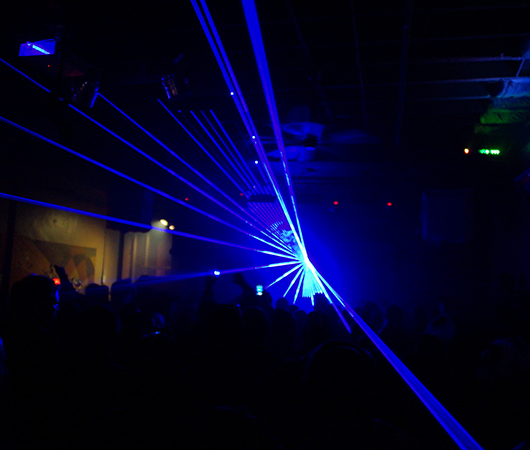
Raving (Sort of) in North Carolina – Eight Things We’ll Remember About the Inaugural Mountain Oasis Electronic Music Summit
Last weekend, XLR8R headed down to Asheville, North Carolina for the first ever Mountain Oasis […]

Last weekend, XLR8R headed down to Asheville, North Carolina for the first ever Mountain Oasis festival. Billed as an “electronic music summit,” the three-night affair was put together by the same promotional crew that was previously responsible for Moogfest. Given our general enjoyment of that event over the years—our review of Moogfest 2012 is here—we were optimistic about the prospects for this new event, even though its eclectic line-up presented a large number of acts that fell outside our usual range of interest. Still, we approached the event with open eyes and ears, and generally found ourselves having a pretty good time. Along the way, we also took note of some particularly memorable moments, which we’ve itemized in an effort to share a bit of our Mountain Oasis experience.
Jacques Greene (by Reggie Tidwell)

Asheville is a quality festival town.
In truth, the Mountain Oasis line-up looked like something hashed out between a college-radio music director and an attendance-minded booker. The artists that played the festival ranged from populist EDM (Bassnectar) to isolationist ambient (William Basinski), and from overly celebrated indie favorites (Neutral Milk Hotel) to 40-plus-year veterans that retain a distinctly cult appeal (Sparks). The line-up even touched upon ’90s alt-rock heroes (Nine Inch Nails) and and modern-day Pitchfork royalty (Animal Collective). From a stylistic perspective, it was all a bit jumbled, but as we mentioned before, the Mountain Oasis crew was previously responsible for booking Moogfest, and it seems that the all-over-the-map line-up is partly a symptom of the two organizations working out aesthetic custody issues.
Curatorial issues aside, Asheville is the kind of place that’s capable of sustaining more than one electronic-music festival. The city is a small, eminently walkable place, and among the five venues hosting Mountain Oasis events, the longest trek festivalgoers had to make was a 10-minute jaunt from a mid-size rock club called the Orange Peel to the ExploreAsheville.com Arena. In addition to the density of its venues, Asheville has a base of open-eared attendees from the local UNC, and it’s also accessible enough to draw fans in from places like South Carolina, Tennessee, and further afield—we spoke with someone who was visiting from Israel, and others from Minneapolis and Seattle who had come specifically to see Neutral Milk Hotel. Plus, with tourist attractions like the Biltmore Estate, the Thomas Wolfe House, a small museum dedicated to Black Mountain College, and a grip of excellent restaurants, there was plenty for visitors to do outside of partying.
King Britt (by Reggie Tidwell)
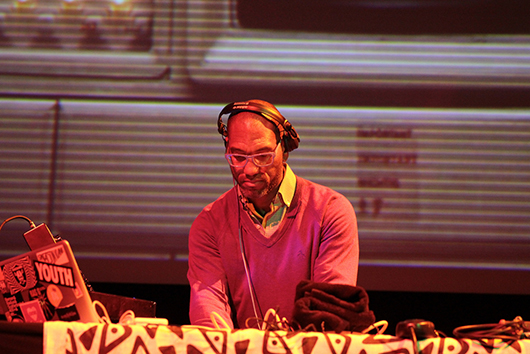
Still, despite the city’s general air of open-mindedness, several festival attendees told us that underground dance-music events remain rare in the area, although the region certainly has its outlets. Chapel Hill’s Nightlight club hosted Ital, $tinkworx, and Dynamo Dreesen the same night that Mountain Oasis started, and Carrboro’s All Day Records is one of the best mail-order distributors for dance music in the country. This base helps explain why the Mountain Oasis organizers felt comfortable putting together a sort of balancing act, one that featured both arena-sized names and more cerebral artists. It may have been a risky proposition, but it generally worked, allowing for a kind of cross-pollination between the EDM massive and more underground heads, all in a low-stakes environment with plenty of alternatives at every turn.
The primary downside of so much variety was an overabundance of choice. On average, at any given point during the festival—which ran from 7 p.m. to 2 a.m. on Friday and Saturday, and from 6 p.m. to 12:30 a.m. on Sunday—three or four events were occurring simultaneously. Still, Mountain Oasis’s organizers deserve credit for keeping the festival’s various threads as separate as they could. For example, juxtaposing Rustie’s trap-happy candy rave and Sparks’ arch cabaret was a savvy way of disappointing as few people as possible. At the same time, with so many options, it was difficult to curb our fear of missing out. As such, the weekend was filled with hasty snap judgments, a feeling of distraction, and crowd sizes that fluctuated wildly. The benefits of settling into a performance were clear when we could make the call to stay still, but just as often, the festival felt like a playlist on shuffle, with too many options to switch over to the next cut.
Laurel Halo (by Reggie Tidwell)
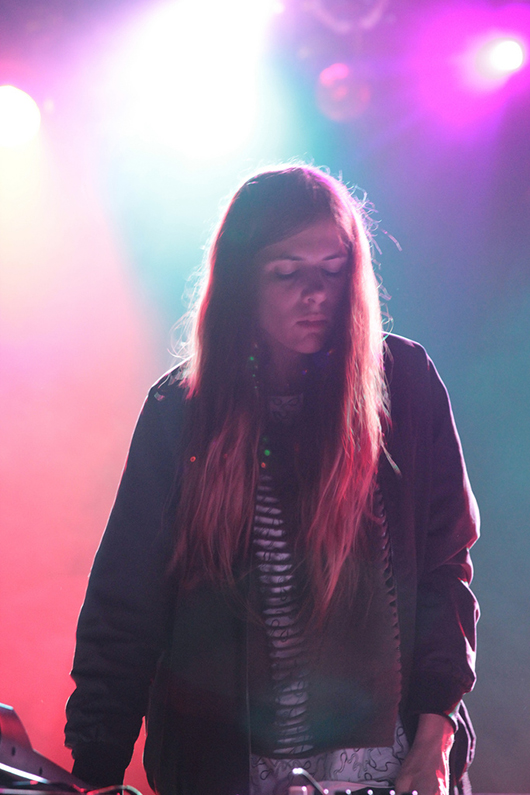
Laurel Halo might have confused the crowd, but we liked what she had to offer.
We’ve caught Laurel Halo at several festivals over the past year, and have usually been impressed with her ability to navigate between extended ambient passages, a ferocious hail of drum machines, and even her own mantra-like vocals. Halo has a reputation for continually evolving her live shows, and her Friday-evening set at the Orange Peel was destabilizing, even for the few people who seemed to know what to expect. The crowd reduced itself by two-thirds following Jacques Greene‘s pleasantly low-key opening set, which managed to make R&B and hip-hop-influenced house sound like slinky gray tech-house. Drawing upon her new Chance of Rain LP, Halo’s performance was vocal-less and even a bit formless, although it drew on a distinctly techno vocabulary. The oceanic masses of drum machine hits and the indistinct miasma of dissonant tones that made up her new live set reminded us of a substantially cleaned-up take on Chain Reaction-era Vladislav Delay. If there was a groove to settle into, it was several degrees removed from the immediate experience of the music, which hit the crowd’s organs as much as their ears, and yet the performance had a quicksilver quality, where its form was constant change. Understandably, she received the most ambivalent reaction from the crowd we witnessed during the whole festival. She started to veer off course somewhere around the midpoint of her set, with harsh tones straight out of a Morton Feldman piece failing to find common ground with confused drum hits, but she let things fall back together after 10 minutes of confusion. More than any other set at Mountain Oasis, Laurel Halo’s performance was a reminder that the means of electronic-music production can be used to question and undermine identity as much as they can be used to create a stable, predictable image.
Rustie (by Reggie Tidwell)

Rustie and Bassnectar shared some stylistic ground, but not too much.
Rustie‘s Glass Swords is still as good as it is tasteless; it’s saccharine done to perfection. There’s nothing subtle about that album’s diamond-eyed anthems, which sound like the kind of glossy, hyper-referential music that should be pumping in an anime warehouse rave. Rustie was slated to perform on Friday night at Mountain Oasis, and the promise of inescapable pleasure softened the blow of leaving Sparks‘ performance at the Diana Wortham Theatre only four songs into the veteran duo’s set. Rustie brought the Orange Peel closer to capacity than Laurel Halo had only hours before, but the venue was still large enough to leave plenty of room for maneuvering. The crowd also had a more diehard raver feel, and old-school standbys like furry boots and gloves with LEDs in the fingertips were in full effect for the first time (although it was only a taste of the no-holds-barred gurning that would accompany Bassnectar‘s arena set later in the evening). Rustie’s recent “Slasherr” b/w “Triadzz” EP found the artist being more overt about his trap leanings, but his live set was even more cutty, focusing on bumping low end and ratcheting hi-hats. It was too thick to resist moving to, but the highlights remained the odd moments when he’d drop a bit of “Surph” or “Slasherr,” which towered over their surroundings like prismatic pyramids. Once he wrapped up, we felt we’d be remiss not to swing by Bassnectar, both for contrast and continuity. The the ExploreAsheville.com Arena was extremely hype, although it was hard to make out the shape of the music, which was constantly exploding and collapsing like some sort of simmering, MSG-enhanced gruel of bass that kept the audience’s sternums vibrating at a resonant frequency. We walked away with no distinct impression, but did have a sort of gratitude about the more adventurous bookings that Bassnectar’s presence enabled.
Sparks (by Brock Caldwell)
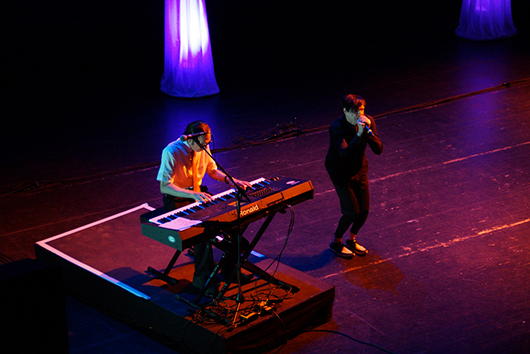
Silver Apples and Sparks headlined a quality crop of electronic veterans.
When Laurel Halo’s set started to track a little wonky, we decided to poke our heads into the Silver Apples show at the nearby Asheville Music Hall. Originally a duo, Silver Apples now comprises singer and synthetist Simeon alone, following drummer Danny Taylor’s death in 2005. The show was more an act of intergenerational ambassadorship than an event in itself, and the anxious edge that makes the group’s recordings still sound so odd has been dulled, not unpleasantly, by age. Sibling duo Sparks, along with Alan Howarth and Gary Numan, were the other elder statesmen at the festival, but the pair came across as galvanized rather than diminshed by its long career; despite the brothers’ age, it seemed like they were still performing in their parents’ rec room strictly for their own amusement. Their tongue-in-cheek take on pop-music forms is not electronic music per se, despite their collaboration with Giorgio Moroder on No. 1 in Heaven, but there’s more than a little philosophical common ground between their constant irony and electronic music’s antagonism toward stable personas.
Ital (by Reggie Tidwell)
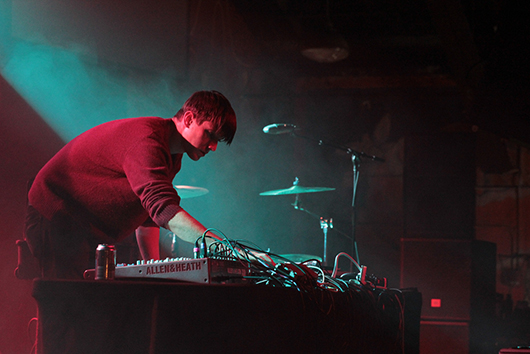
Actress, The Bug, and Ital brought the bass—and the heady electronics.
Ital warmed up the Orange Peel crowd on Saturday night, playing a set of warm and slightly cracked house rollers. Truthfully, we weren’t sure what to expect in terms of audience engagement, especially given the previous night’s Laurel Halo performance and Ital’s proclivity for live processing and tendency to get somewhat noisy at points. However, his set hewed closer to the sound of his recent 12″ for the storied Workshop label than the somewhat conceptual excursions filling out his two albums for Planet Mu, and the audience was intensely receptive, sending forth cries for even minor changes in direction.
But in terms of sheer damage, not even Bassnectar’s constant bass rattle could rival the nuclear assault that came from The Bug. The sliver of overlap between EDM’s pyrotechnics and The Bug’s bass-frequency science was more of the more fortuitous collisions at Mountain Oasis. On a visceral level, The Bug’s appeal was not lost on the crowd, even as it drew on a great deal of musical knowledge; his music is a melting pot of UK and Jamaican music descended from soundsystem culture, all infused with the grit of his earlier Techno Animal project with Justin Broadrick.
Actress was much harder to categorize. His live sets are never a sure bet, although it’s hard to tell the extent to which this is intentional. During his closing set on Saturday, he would occasionally lock into some sort of satisfying pattern, only to pull things back to a more protean, murky place. Judging from the excellence of his productions, it’s easy to assume that he’s simply on some other level and doesn’t care if we’re caught up, but another part of his live show does indeed seem intentionally sloppy and alienating, as if he’s uncomfortable with too much coherence. Still, Actress spent as much time being very good as he did being inscrutable, and was sometimes both at once, as when he closed his set with the tremendous “Raven,” only to take big chunks out of it with the crossfader. The set started out with bpms and track lengths comparable to his last release, the languid Silver Cloud EP, but the music offered little of the sonic clarity that lifted those tracks up above their torpor. Even as he transitioned into faster tempos and squelchy, crowd-baiting acid lines—almost hitting a Helena Hauff note—a compressed fog of low-mids sat stubbornly in the center of the mix. Ultimately, Actress ended up coming across as one of the highlights and one of the disappointments of the festival, taking listeners with him only to disappear behind a corner three blocks ahead.
Raime (by Reggie Tidwell)
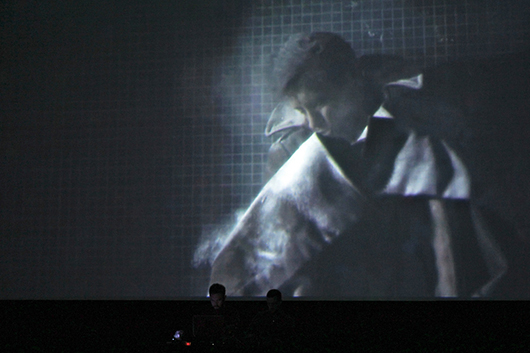
Raime was intense.
Raime’s Quarter Turns over a Living Line doesn’t scream out to be played at max volume—it’s autumnal, spare, and seemingly best served as a kind of atmospheric coloring. However, seeing the duo’s live set on Saturday at the Diana Wortham Theatre made us realize that the pair’s music works in a very different fashion than one might expect. Raime was preceded by the US debut of King Britt‘s Fhloston Paradigm project, which presented a cosmic arc of slowly evolving synth-and-drums improvisations, the music fleshed out with wordless, deep-space wails for maximum dramatic effect. It was a lot to follow, but Raime transformed the venue dramatically, dropping the audience into Hades with pitch-perfect videos that underlined the sustained, glacial intensity of the songs’ squealing samples. In one, a man in a chalky trenchcoat was writhing but hellishly incapable of pulling himself out of a nightmare; elsewhere, a man was pouring handfuls of construction dust over his back in some act of industrial penance. As striking as these images were, it was perhaps even more important that Raime pushed the bass to the forefront, so much so that the reluctant vibration of the theatre’s walls became an integral frequency. It was music of the long post-industrial nightmare, and something ideally suited to a seated experience. When we stood up after that onslaught, we felt as ghostly as the images that had populated the screen.
Mount Kimbie (by Reggie Tidwell)
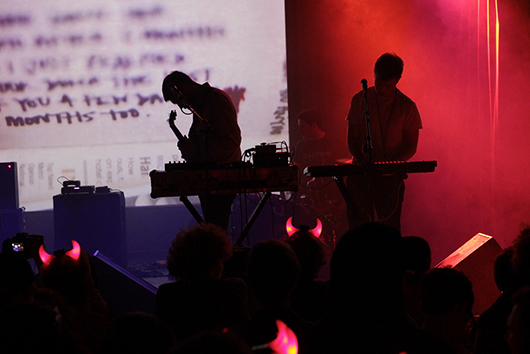
Mount Kimbie capped a solid final night.
The last night of Mountain Oasis was its most song-oriented, as it featured sets from like-minded R&B fetishists Autre Ne Veut and How to Dress Well, along with a few UK acts on the cusp of the underground and something resembling broader acclaim: Jessie Ware, Disclosure, and Mount Kimbie.
Autre Ne Veut’s songs might be more obviously engaging than navel-gazing efforts of How to Dress Well, but their live sound at the Orange Peel was both murky and bombastic, which was a little strange considering that the only live elements were the singing itself and a somewhat superfluous, too-loud drum kit. Arthur Ashin laid into his songs with conviction, but also failed to hit his marks on the slo-mo strafe of “Ego Free Sex Free,” and it was difficult to tell whether his struggles merely stemmed from a miscalculated attempt to add some live juice to an Ableton performance or whether he was suffering from the same kind of monitor issues that Sparks and How to Dress Well openly complained about.
Bassnectar (by Scott Criss)
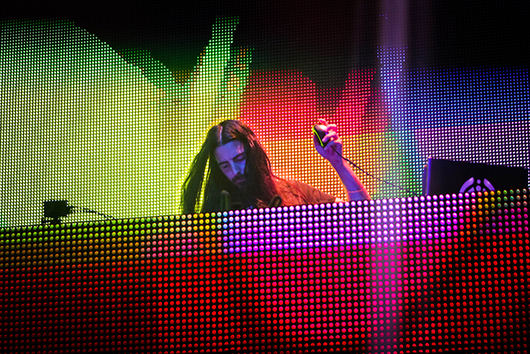
As the evening continued, Jessie Ware and How to Dress Well’s Tom Krell were responsible for some of the most entertaining stage banter of the entire festival, not that the competition was particularly stiff. Ware big-upped several couples at the Thomas Wolfe Auditorium for making out before doing a pocket cover of collaborator Julio Bashmore’s “Battle for Middle You.” Back at the Orange Peel, Krell dropped a couple aw-shucks gems. Prior to a new song called “Repeat Pleasure,” he said, “This song’s called ‘Repeat Pleasure’ and it’s about how desire will never be satisfied basically.” Things got a bit darker during his end-of-set ramble, as he shared, “I wanna have a baby at some point in my life, but I’m freaked out about them dying.” On the subject of his grandmother, who recently passed, he simply offered, “She was a bad bitch.” As for the music, his songs were technically not as overwrought as Autre Ne Veut’s, yet they somehow still came across as more overwrought that Autre Ne Veut’s, although assists from a pianist and cellist made the sound and intended affect much more legible and effective.
Before the night closed with the closest thing to an extended DJ set from The Orb—which presented two hours of slowly skanking, brightly colored, and movie-dialogue-festooned aquatic dub, packed in the thick syrup of Thomas Fehlmann and Alex Paterson’s childlike wonder—Mount Kimbie proved itself to be an unaccountably powerful live band. Projecting slides that appeared to be a kind of twentysomething Lomography parody of Godspeed You Black Emperor’s apocalyptic sandwich-board imagery—lovers’ pictures taken on vacation to New York, and cloudbanks with words like “PAIN” scrawled in red Sharpie on top—the duo drew primarily on its last album, Cold Spring Fault Less Youth, playing much of it live, including individual kicks. The singing could have been higher in the mix, but the imbalance served to underline the fact that, rather than retreating into the comfortable value system of songwriting, Mount Kimbie’s productions remain precise, and the group has found a way to go deeper into its own sound world while still leaving a few signposts up.
The Bug (by Reggie Tidwell)
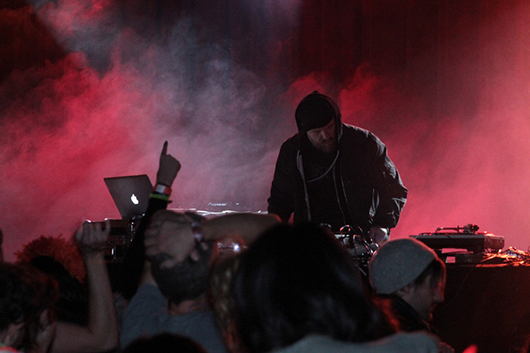
When we weren’t rushing around, Mountain Oasis was quite fun.
Like any festival with such wide-ranging ambitions, Mountain Oasis’ strengths were intimately bound up with its shortcomings. Despite the best efforts of its programmers, we often found ourselves cutting out of a show less than a half hour after arriving, hoping not to miss part of another show that was happening a few blocks away. That said, when our aesthetic preferences and the program aligned, and an opportunity to settle down arose, the results were deeply involving on both the pop and experimental ends of the spectrum. And, however rushed we may have felt, things ran extremely smoothly, which was no easy task when one remembers that organizers were responsible for coordinating five venues over three days. Moreover, the venues themselves were solid and varied; each one was well suited to the acts they hosted, and the crowds were friendly and receptive, even to music that may have fallen outside their personal tastes. While the festival’s eclectic line-up was likely due as much to Mountain Oasis’ split from Moogfest (and a simple need to be economically viable) as it was any sort of innovative curatorial vision, it was still thrilling to see a huge undertaking such as this refuse to stay in any given lane. Granted, dance-music diehards didn’t find hours-long DJ sets and afterparties at Mountain Oasis—dance and electronic culture doesn’t exist on that scale in Asheville just yet—but it was hard to be disappointed when we were given the opportunity to see Sparks and Actress at the same festival.

